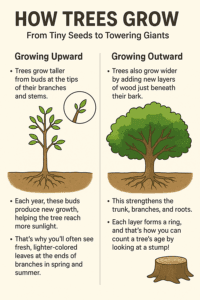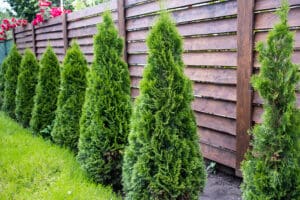
Trees may start as tiny seeds, but over time, they become the towering giants that shape our landscapes. Their growth happens in two main ways: upward and outward.
Growing Upward
Trees grow taller from buds at the tips of their branches and stems. Each year, these buds produce new growth, helping the tree reach more sunlight. That’s why you’ll often see fresh, lighter-coloured leaves at the ends of branches in spring and summer.
Growing Outward
Trees also grow wider by adding new layers of wood just beneath their bark. This strengthens the trunk, branches, and roots. Each layer forms a ring, which is how you can count a tree’s age by looking at a stump!

Read more about the Lifecycle of a Tree.
Fast vs. Slow: How Quickly Trees Grow
Not all trees grow at the same pace. Some shoot up quickly, while others take centuries to grow just a few inches.
Fastest Growing Tree: Empress Tree

The Empress Tree (Paulownia tomentosa) can grow 3–6 meters in just one year! It’s ideal for quick shade, erosion control, and timber. Other fast growers include eucalyptus and hybrid willows, which also reach impressive heights in a short time.
Find out about more Fastest Growing Trees here in an article from the Woodland Trust.
Slowest Growing Tree: White Cedar

The White Cedar (Thuja occidentalis) grows incredibly slowly. Some trees in Canada have grown only 4 inches in 155 years! Despite their slow growth, these trees can live for over 1,000 years, demonstrating remarkable endurance and resilience.
Why Tree Growth Speed Matters
Whether fast or slow, every tree plays a vital role in nature. This reminds us that growth comes in many forms and at many speeds.